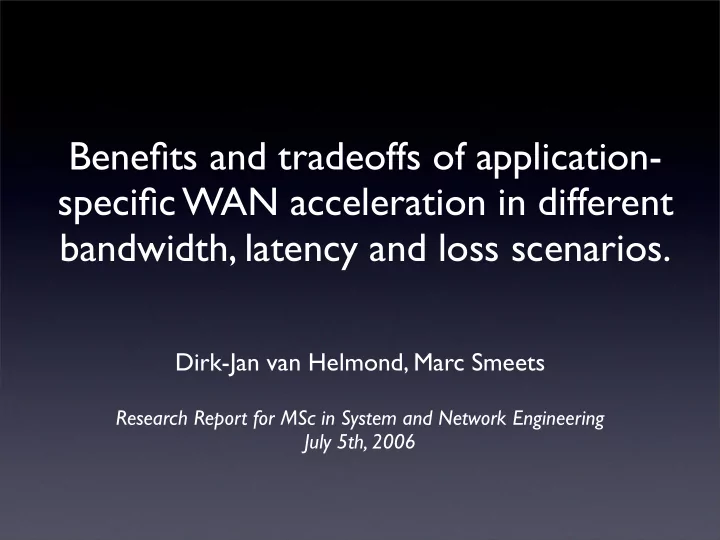

Benefits and tradeoffs of application- specific WAN acceleration in different bandwidth, latency and loss scenarios. Dirk-Jan van Helmond, Marc Smeets Research Report for MSc in System and Network Engineering July 5th, 2006
Agenda • IT trends and inner-workings of WX and AppFlow • Considerations of protocol optimization • Test lab and lab considerations • Tests performed • Test results • Difficulties of the WX platform • Conclusion of results
IT trends • Centralization of services (e.g. email, storage) • Usage of LAN protocols over WAN links • Problem: different link characteristics
Working of the WX • 2x WX on both sides work as a black box • Caching, Compression • TCP Optimization • TCP window size • Bandwidth*delay product • Application Acceleration • CIFS, MAPI, HTTP
Why application layer acceleration works • CIFS, MAPI and HTTP • HTTP by pre-fetching objects • CIFS and MAPI by eliminating protocol inefficiencies (window size = 1)
No acceleration
AppFlow Acceleration
Inline protocol optimization • Vendors start to optimize their protocols • These products exist by grace of Microsoft • Otherwise Legacy/Niche market • Total disregard of the OSI layered model • Choice: bad performance or rule breaking • Problems with troubleshooting/compatibility
Expected scenario
Actual scenario
Test lab • 2x Juniper WX 250 Appliances • 1x Windows 2003 File and Exchange Server • 1x Windows XP client with Outlook • 1x FreeBSD router • 1x FreeBSD Link simulator (dummynet) • 1x FreeBSD sniffer (tcpdump on a spanport)
Test Setup
Considerations • Keeping the link clean • All management out of band • Disabled all unused protocols • Empirical testing • Measurement by observation through packet inspection • Anomalies and unexplainable results marked, not investigated due to limited time
Measurement • Products of the equation • Volume is a known constant • Time needed for throughput measurement • Time measured with protocol inspector • ∆ t of first block and last block
Measurement (cont’d) • Interested in AppFlow acceleration • No caching and compression • Files used are random binaries • Two tests to differentiate between TCP optimization and AppFlow acceleration
Tests done • Baseline of no acceleration of any kind • TCP yes, compression no • CIFS • MAPI XP • MAPI 2003 (not yet fully supported by WX) • Error correction
Link scenarios • Bandwidth: • T1 like speed = 1,544 Mbit/sec • OC-1 like speed = 51,84 Mbit/sec • Delay (one-way): • 0 ms = local link • 30 ms = national link • 100 ms = transatlantic link • 250 ms = satellite link
Testing CIFS • Configure WX, reboot, mount share, open share in new window • Configure WX, start tcpdump, ping, file transfer, ping close tcpdump • Open PCAP , note time SMB offset 0 and last offset, calculate time and throughput
Testing MAPI • Configure WX, mail enough 10MB files, disable preview pane, reboot • Configure WX, open mail, start tcpdump, ping, save-as, ping, stop tcpdump, close mail • Open PCAP , note time first and last RPC, calculate time and throughput
Testing loss • Take scenarios tested that might be interesting • configured chances of loss: • 0,1 0,05 0,01 0,005 0,001 • Do the exact same way of testing
Test results • CIFS T1 & OC-1 • MAPI (XP) T1 & OC-1 • MAPI (2003) T1& OC-1 • Loss: • CIFS OC-1, 0 ms • MAPI (XP) OC-1, 0 ms • MAPI (XP) OC-1, 250 ms
Delay Base TCP AFA Benefit 0ms 176,6 76,5 97,5 - 44.7% 30ms 131,8 67,8 79,4 - 39.7% 100ms 83,6 54,6 73,7 - 11.7% 250ms 42.7 34,2 62 45.4%
Delay Base TCP AFA Benefit 0ms 4294.6 1347,6 2008,7 - 53.2% 30ms 425,4 357,6 1373,4 222.8% 100ms 126,1 139,5 774,7 514.3% 250ms 52,3 59,7 375,4 617.4%
Delay Base TCP AFA Benefit 0ms 175.1 165.7 148.9 - 14.9% 30ms 116.0 126.1 136.7 17.9% 100ms 32.1 78.8 120.1 274.1% 250ms 14.3 44.1 98.2 585.7%
Delay Base TCP AFA Benefit 0ms 3688,3 1191,4 1969,9 - 46.6% 30ms 243,9 320,4 1949,9 652.5% 100ms 44,3 126,2 1706,2 3752.9% 250ms 17,9 15 953,6 5205.5%
Delay Base TCP AFA Benefit Exchange Benefit 0ms 174 153,8 164,9 - 5.2% 170,8 - 1.8% 30ms 116,1 110,1 124,5 7.2% 111,7 - 3.8% 100ms 59,1 57,8 79,4 34.3% 58,7 - 0.9% 250ms 27,7 26,4 44,5 60.5% 27,2 - 1.8%
Delay Base TCP AFA Benefit Exchange Benefit 0ms 3447,1 829,6 1234,4 - 64.2% 2600,4 - 24.6% 30ms 244,9 183,3 337,8 37.9% 243,4 - 0.6% 100ms 72,8 68,8 131,2 80.1% 74,5 2.3% 250ms 25,5 28,7 57,8 125.9% 29,9 17.2%
0,001 0,005 0,01 0,05 0,1 No FEC 2856,01 3263,278 1202,849 190,276 0 FEC 4417,992 2090,559 1159,407 152,972 0 Benefit 54.7% - 36.0% - 3.6% - 19.6% -
0,001 0,005 0,01 0,05 0,1 No FEC 3175,211 1752,428 715,445 134,71 0 FEC 3253,187 1671,632 1008,115 131,317 0 Benefit 2.5% - 4.6% 40.9% - 2.5% -
0,001 0,005 0,01 0,05 0,1 No FEC 718,665 618,808 511,205 299,471 162,352 FEC 735,539 587,953 534,195 277,04 155,296 Benefit 2.3% - 5.0% 4.5% - 7.5% - 4.3%
Conclusion
Conclusion MAPI 2003
Final Conclusion • Very good performance of CIFS, MAPI acceleration • Better acceleration than Microsoft with Exchange 2003 • No significant performance increase FEC • Disregard of the OSI layered model
Questions ?
Recommend
More recommend